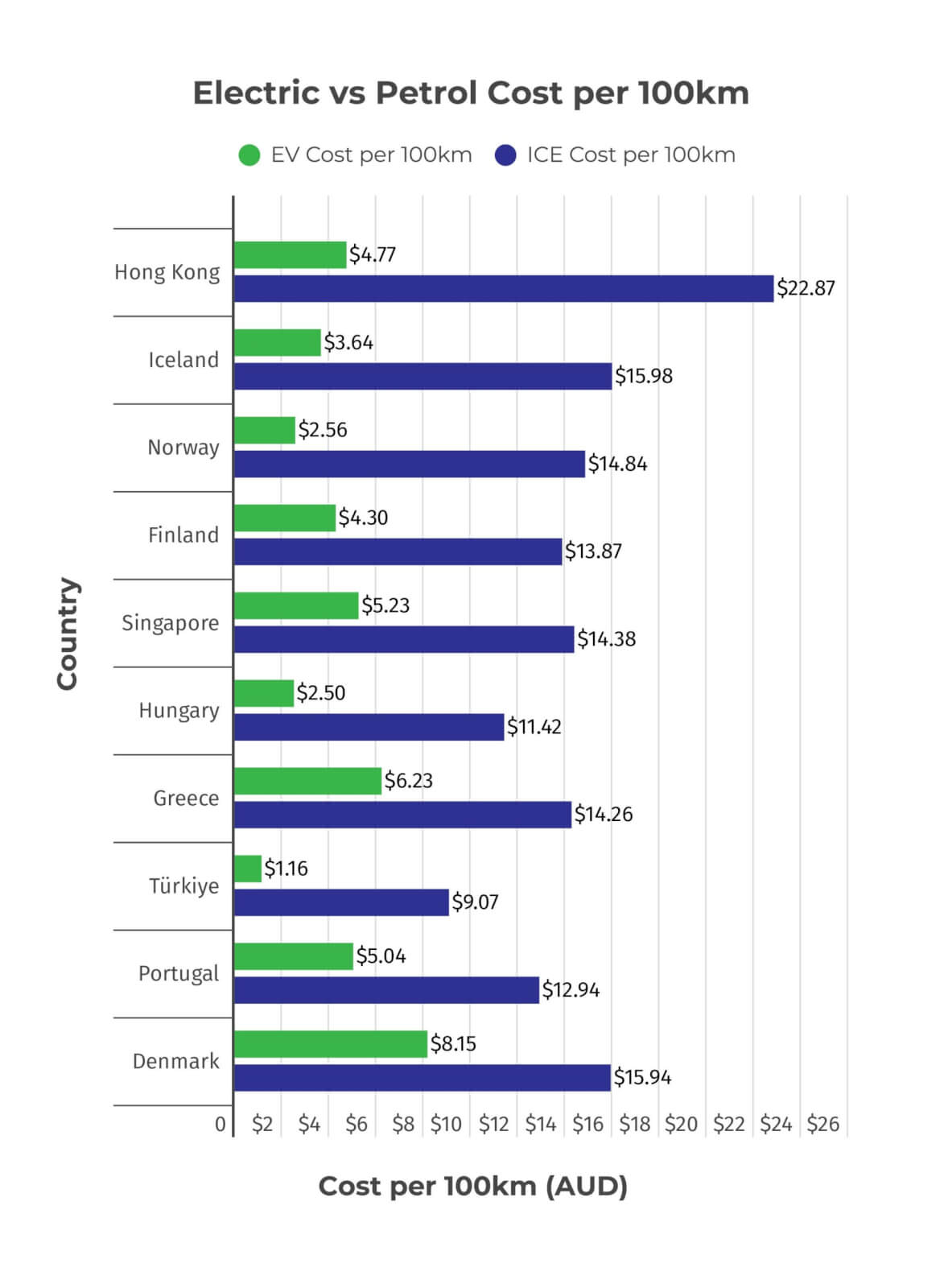The Burrow

Making the electric vehicle (EV) switch is one way to save money due to generally lower charging costs compared to refuelling a petrol- or diesel-powered vehicle.
But where in the world is it cheapest and most expensive to charge an EV?
As experts in helping Australians compare energy plans, we looked at the average national electricity prices of almost 70 countries to find out the cost to charge the world’s most popular electric car, the Tesla Model Y.1
We also compared energy with petrol costs using the internal combustion engine (ICE) powered Toyota RAV4 Hybrid 2WD country-by-country.
Based on calculating average national energy prices with the base Tesla Model Y RWD’s 57.5kWh usable battery pack, Ireland topped the list as the most expensive country to charge the electric SUV.
It was followed by Italy, Liechtenstein, and the United Kingdom – with the 10 most expensive list filled by European nations.
However, while it may cost AU$12.53 to charge an EV in Ireland for every 100 kilometres of driving, it’s still cheaper than running the internal combustion engine powered Toyota RAV4 Hybrid 2WD, which costs $22.87 per 100km at most to refuel in Hong Kong.
Australia placed 14th most expensive, costing Model Y RWD owners around $6.63 per 100km.
| Country | Typical cost per kWh (AUD) | Cost per full battery charge (AUD) | Cost per 100km (AUD) |
| Ireland | $0.798 | $45.89 | $12.53 |
| Italy | $0.685 | $39.39 | $10.75 |
| Liechtenstein | |||
| United Kingdom | $0.669 | $38.47 | $10.50 |
| Belgium | $0.645 | $37.09 | $10.13 |
| Germany | $0.597 | $34.33 | $9.37 |
| Latvia | $0.547 | $31.45 | $8.59 |
| Czechia | $0.527 | $30.30 | $8.27 |
| Denmark | $0.519 | $29.84 | $8.15 |
| Netherlands | $0.516 | $29.67 | $8.10 |
The most expensive country for electricity was Ireland, where it is nearly 20 times more expensive to charge the Tesla Model Y RWD in Laos.
Vietnam was followed by China, Belarus, and Pakistan as cheapest nations for EV charging globally.
It’s worth noting that some countries in the bottom 10 have a lower-middle income developing economy, so cheaper electricity prices are relative to wages and affordability.
Compared to Malaysia – the cheapest country for buying petrol – it costs $3.07 per 100km to power the petrol-powered Toyota RAV4 Hybrid 2WD. This is still substantially more than the Tesla’s $0.63 per 100km running cost in Laos.
| Country | Typical cost per kWh (AUD) | Cost per full battery charge (AUD) | Cost per 100km (AUD) |
| Laos | $0.040 | $2.30 | $0.63 |
| Qatar | $0.047 | $2.70 | $0.74 |
| Malaysia | $0.070 | $4.03 | $1.10 |
| Saudi Arabia | $0.072 | $4.14 | $1.13 |
| Türkiye | $0.074 | $4.26 | $1.16 |
| Pakistan | $0.103 | $5.92 | $1.62 |
| Belarus | $0.113 | $6.50 | $1.77 |
| China | |||
| Vietnam | $0.114 | $6.56 | $1.79 |
| India | $0.116 | $6.67 | $1.82 |
Hongkongers would most benefit from making the electric switch, with the widest price difference to run an EV versus a petrol-electric hybrid vehicle. The Tesla Model Y RWD was $18.09 cheaper to run per 100km than the Toyota RAV4 Hybrid 2WD in the city.
Those driving an EV in Iceland and Norway also have a bigger advantage in running costs, saving $12.33 and $12.28 per 100km respectively compared to refilling a petrol-electric hybrid car.
However, the price difference is less in Ireland where it’s only $1.00 per 100km cheaper to run the Tesla than Toyota.
It’s worth noting that fuel prices tend to fluctuate depending on the cycle, and the running cost difference will vary from the recorded figures listed in this study.

View the full ranking here.
This study highlights that electricity prices can vary country-by-country due to factors including government and climate policies, infrastructure costs, and the local generation mix.
Compare the Market’s Head of Energy, Meredith O’Brien, said switching to an electric car already provides reduced running costs compared to petrol or diesel vehicles – but there are even more opportunities to save money.
“Electricity prices vary country-by-country depending on a variety of factors such as the local generation mix, infrastructure costs, government policies and, ultimately, the retailer,” Ms O’Brien said.
“That’s why it pays to regularly compare your energy plan to potentially save money on EV charging and overall household usage costs.
“EV owners could also utilise free solar energy when there’s sunlight or sign up to a dedicated EV energy plan that provides generally lower rates or free charging during peak solar export periods. But make sure to check that general household usage tariffs aren’t costing more than the standard plan.”
National average electricity (per kilowatt-hour) and fuel (95 RON premium unleaded petrol per litre) prices for nearly 70 countries were sourced from GlobalPetrolPrices’ latest available data.
To compare the running costs of electric vehicle and petrol-electric hybrid SUVs, the sums were based on the following models and manufacturer consumption claims:
To calculate the running costs of the EV, each nation’s average electricity price was multiplied by the usable (net) battery size to identify the cost of a full recharge (0 to 100%), and multiplied by the vehicle’s claimed energy consumption to identify the cost per 100km.
To calculate the running costs of the ICE hybrid, each nation’s average electricity price was multiplied by the fuel tank volume to identify the cost of a full refill, and multiplied by the vehicle’s claimed fuel consumption to identify the cost per 100km.
Both medium SUV models were selected due to having a similar price and size, comparable features list, and popularity globally as buyers shift towards hybrid and electric vehicles.
Additional sources: